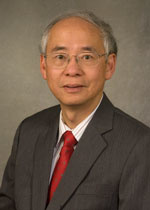Check out a list of careers that are expected to be in demand in coming years and actuary will almost always be near the top.
And then the first question so many people ask when they think of actuary comes up: what does an actuary do? Beyond something that involves math and insurance, explanations always seem rather mysterious and bizarre, something that only other practitioners of actuarial science can really understand.

But Elias Shiu, professor of statistics and actuarial science and senior actuary faculty in the University of Iowa College of Liberal Arts and Sciences, says it’s not that difficult.
“Actuaries use past experiences to construct tables that determine the likelihood of something bad happening,” he says. “Insurance companies and governments can use them to determine premiums, reserves and cash values.”
That is, at its heart, actuary is figuring out when people might die so that life insurance companies can figure out what policyholders’ premiums should be. Shiu says life insurers want an estimate of when policyholders might die so that the premiums provide enough cash to pay out claims. If too many policyholders die at once, claims might sap all of the company’s cash and hurt the bottom line, or, in the worst-case scenario, drive the company out of business.
To do that, they build intensely comprehensive mathematical models that predict when people will die based on health and lifestyle factors. Or, as one actuary put it in the profession’s publication, Actuary, they build “excruciatingly complex models of small bits of the world.”
In the process, they come up with fascinating nuggets like this (also from Actuary): people whose favorite activity is gardening have a 4.55 percent prevalence of cardiovascular disease, while those whose favorite activity is jogging have only a .6 percent prevalence of cardiovascular disease, which means gardeners are more than seven times more likely to have cardiovascular disease than runners. Even more interesting is that people whose favorite activity is walking for health have a cardiovascular presence of 4.03 percent, which makes them still six times more likely to have cardiovascular disease than joggers.*
* Of particular interest to Iowa Citians—those whose favorite activity is avid book reading have a presence of cardiovascular disease of 3.91 percent, which makes them less likely to have cardiovascular disease than people who walk for health.
While these numbers might be abstractly interesting to most people, they can be worth millions of dollars to insurance companies. These figures help them figure out what premiums to charge policyholders, ensuring they have enough cash to pay out anticipated claims while staying profitable. If they have more policyholders who jog than garden, they need less cash on hand because fewer of them are likely to die of cardiovascular disease and anticipated claims will be lower. More gardeners means more cash on hand.
Other forms of insurance also use actuaries in their lines to determine, for instance, the likelihood of a house burning down or of a driver getting into a car accident, to set home insurance or auto insurance premiums. Pension management firms and retirement funds use actuaries, and companies also incorporate actuarial science into their risk management. The Social Security Administration uses actuaries to set monthly paybacks to retired persons.*
* One of UI’s most notable actuarial alumni was Robert Myers, who joined the Social Security Administration as one of its first employees in 1934 and was responsible for setting the retirement age at 65. He was SSA’s chief actuary from 1947 to 1970 and died in 2010. Myers was also president of the Society of Actuaries, one of five alumni to achieve one of the profession’s highest honors in the 100-year plus history of UI’s program, which is one of only two in the United States that have reached the century mark.
What does actuary mean, anyway? The term actuary is derived from the Latin term “actuarius,” which means copyist or account keeper, and is itself derived from the term “actus,” meaning public business. In the 16th century it came to be used as a term for a registrar or clerk, and was first applied in the insurance profession in 1849. Thanks to the Online Etymology Dictionary.
And for their work, actuaries are rewarded handsomely. An actuary who has only the bare minimum qualifications will be paid an annual salary of $46,000 the moment her diploma is in hand. Shiu says some top students can expect a starting salary closer to $80,000, depending on how many certification tests they pass and where they work.
Despite that demand and high salary, students do not flock to the field. The UI, for instance, has only 50 actuarial science majors this year, and 165 interests, or pre-actuary majors.*
* Only about half of whom will ever become actuary majors, the others having washed out in the math-intense pre-actuary program, or find a major they like better. Shiu says the actuary profession is not easy to get into. Not only do some university programs have strict admission requirements, but the certification exams required for entrance into the profession are designed with a 60 percent failure rate, although students who fail can take the exam as many times as they want.**But while it’s stressful to get into, Shiu says the actuary profession itself is decidedly low-stress and is frequently identified as one of the least stressful among well-paying jobs.
** A sample question from the 1992 exam, and this is one of the easier ones…..In a random sample of 15 residents of Tampa, the time (in minutes) spent commuting to work has a sample mean of 47.21 and an unbiased sample variance of 135. If commute times are normally distributed, then what is the shortest 90 percent confidence interval for the mean commute time?
While demand is high, Shiu says that’s not because U.S. companies employ tons of them. They don’t. There are no armies of actuaries. Even companies that employ actuaries don’t employ as many of them as they do sales reps or marketing people or financial managers. The demand, he says, stems from a limited supply of qualified people to fill what positions there are.
This doesn’t apply to China, where insurance companies are booming because so much wealth has been created in the past 30 years that people need to insure—which Shiu says wasn’t the case when the country’s population was mostly peasant farmers. That global need for actuaries is reflected in the fact that 32 of the UI’s 50 current actuarial majors are international students. In fact, four of the largest insurance companies in Beijing employ UI alumni as chief actuaries.
Shiu says actuary programs have to market themselves and recruit for students because not many kids grow up dreaming of becoming an actuary, or have even ever heard of an actuary. He says the kind of student who goes into the field likes math,* wants to go into business, and has a sense of humor.
* Shiu says this is another reason so many majors are international students—not many American students are excited by advanced math.
Ming Tran and Kyle Sewright are seniors from Des Moines majoring in actuarial science. Both are mathematically inclined and picked actuarial science because of its intensive focus on numbers.
“It’s math, statistics, and business all wrapped into one,” says Tran.
Sewright admitted he really wasn’t sure what actuaries were even after he was majoring in it, and his parents worked for insurance companies. “I didn’t have a clear understanding of actuarial science for the first year and a half.”
But, unlike other math-heavy majors like accounting or economics or mathematics, they like actuarial science because it allows for more creativity and is rooted in reality.
“It’s a practical application of math in the real world,” says Sewright. “There’s a thousand different ways you can approach a question, and you don’t have to worry about finding a definitive answer down to the dollar.”
“Math at a higher level is all about proofs, it’s very abstract and I can’t see it,” says Tran. “In actuarial science, you’re looking at car accidents or other things that I understand.”
Both will graduate in May, and despite a stubbornly high unemployment rate, neither of them had problems finding work. Both had three job offers—Sewright picked The Principal in Des Moines; Tran took Milliman Consulting, in its Milwaukee office.
“It’s going to be an exciting adventure,” says Tran.
